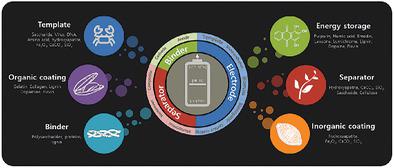当前位置:
X-MOL 学术
›
Adv. Mater.
›
论文详情
Our official English website, www.x-mol.net, welcomes your
feedback! (Note: you will need to create a separate account there.)
Gifts from Nature: Bio-Inspired Materials for Rechargeable Secondary Batteries
Advanced Materials ( IF 27.4 ) Pub Date : 2021-08-01 , DOI: 10.1002/adma.202006019 Chang-Heum Jo 1 , Natalia Voronina 1 , Yang-Kook Sun 2 , Seung-Taek Myung 1
Advanced Materials ( IF 27.4 ) Pub Date : 2021-08-01 , DOI: 10.1002/adma.202006019 Chang-Heum Jo 1 , Natalia Voronina 1 , Yang-Kook Sun 2 , Seung-Taek Myung 1
Affiliation

|
Materials in nature have evolved to the most efficient forms and have adapted to various environmental conditions over tens of thousands of years. Because of their versatile functionalities and environmental friendliness, numerous attempts have been made to use bio-inspired materials for industrial applications, establishing the importance of biomimetics. Biomimetics have become pivotal to the search for technological breakthroughs in the area of rechargeable secondary batteries. Here, the characteristics of bio-inspired materials that are useful for secondary batteries as well as their benefits for application as the main components of batteries (e.g., electrodes, separators, and binders) are discussed. The use of bio-inspired materials for the synthesis of nanomaterials with complex structures, low-cost electrode materials prepared from biomass, and biomolecular organic electrodes for lithium-ion batteries are also introduced. In addition, nature-derived separators and binders are discussed, including their effects on enhancing battery performance and safety. Recent developments toward next-generation secondary batteries including sodium-ion batteries, zinc-ion batteries, and flexible batteries are also mentioned to understand the feasibility of using bio-inspired materials in these new battery systems. Finally, current research trends are covered and future directions are proposed to provide important insights into scientific and practical issues in the development of biomimetics technologies for secondary batteries.
中文翻译:

大自然的馈赠:可充电二次电池的仿生材料
自然界中的材料已经进化为最有效的形式,并在数万年间适应了各种环境条件。由于其多功能性和环境友好性,已经进行了许多尝试将仿生材料用于工业应用,从而确立了仿生学的重要性。仿生学已成为在可充电二次电池领域寻求技术突破的关键。在这里,讨论了可用于二次电池的仿生材料的特性以及它们作为电池主要组件(例如,电极、隔膜和粘合剂)的应用优势。使用仿生材料合成结构复杂的纳米材料,生物质制备的低成本电极材料,还介绍了用于锂离子电池的生物分子有机电极。此外,还讨论了天然衍生的隔膜和粘合剂,包括它们对提高电池性能和安全性的影响。还提到了包括钠离子电池、锌离子电池和柔性电池在内的下一代二次电池的最新发展,以了解在这些新电池系统中使用仿生材料的可行性。最后,涵盖了当前的研究趋势并提出了未来的方向,为二次电池仿生技术发展中的科学和实践问题提供重要见解。包括它们对提高电池性能和安全性的影响。还提到了包括钠离子电池、锌离子电池和柔性电池在内的下一代二次电池的最新发展,以了解在这些新电池系统中使用仿生材料的可行性。最后,涵盖了当前的研究趋势并提出了未来的方向,为二次电池仿生技术发展中的科学和实践问题提供重要见解。包括它们对提高电池性能和安全性的影响。还提到了包括钠离子电池、锌离子电池和柔性电池在内的下一代二次电池的最新发展,以了解在这些新电池系统中使用仿生材料的可行性。最后,涵盖了当前的研究趋势并提出了未来的方向,为二次电池仿生技术发展中的科学和实践问题提供重要见解。
更新日期:2021-09-14
中文翻译:

大自然的馈赠:可充电二次电池的仿生材料
自然界中的材料已经进化为最有效的形式,并在数万年间适应了各种环境条件。由于其多功能性和环境友好性,已经进行了许多尝试将仿生材料用于工业应用,从而确立了仿生学的重要性。仿生学已成为在可充电二次电池领域寻求技术突破的关键。在这里,讨论了可用于二次电池的仿生材料的特性以及它们作为电池主要组件(例如,电极、隔膜和粘合剂)的应用优势。使用仿生材料合成结构复杂的纳米材料,生物质制备的低成本电极材料,还介绍了用于锂离子电池的生物分子有机电极。此外,还讨论了天然衍生的隔膜和粘合剂,包括它们对提高电池性能和安全性的影响。还提到了包括钠离子电池、锌离子电池和柔性电池在内的下一代二次电池的最新发展,以了解在这些新电池系统中使用仿生材料的可行性。最后,涵盖了当前的研究趋势并提出了未来的方向,为二次电池仿生技术发展中的科学和实践问题提供重要见解。包括它们对提高电池性能和安全性的影响。还提到了包括钠离子电池、锌离子电池和柔性电池在内的下一代二次电池的最新发展,以了解在这些新电池系统中使用仿生材料的可行性。最后,涵盖了当前的研究趋势并提出了未来的方向,为二次电池仿生技术发展中的科学和实践问题提供重要见解。包括它们对提高电池性能和安全性的影响。还提到了包括钠离子电池、锌离子电池和柔性电池在内的下一代二次电池的最新发展,以了解在这些新电池系统中使用仿生材料的可行性。最后,涵盖了当前的研究趋势并提出了未来的方向,为二次电池仿生技术发展中的科学和实践问题提供重要见解。











































 京公网安备 11010802027423号
京公网安备 11010802027423号